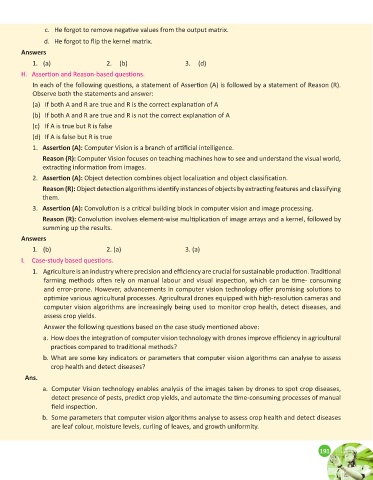Page 325 - AI Computer 10
P. 325
c. He forgot to remove negati ve values from the output matrix.
d. He forgot to fl ip the kernel matrix.
Answers
1. (a) 2. (b) 3. (d)
H. Assertion and Reason-based questions.
In each of the following questi ons, a statement of Asserti on (A) is followed by a statement of Reason (R).
Observe both the statements and answer:
(a) If both A and R are true and R is the correct explanati on of A
(b) If both A and R are true and R is not the correct explanati on of A
(c) If A is true but R is false
(d) If A is false but R is true
1. Asserti on (A): Computer Vision is a branch of arti fi cial intelligence.
Reason (R): Computer Vision focuses on teaching machines how to see and understand the visual world,
extracti ng informati on from images.
2. Asserti on (A): Object detecti on combines object localizati on and object classifi cati on.
Reason (R): Object detecti on algorithms identi fy instances of objects by extracti ng features and classifying
them.
3. Asserti on (A): Convoluti on is a criti cal building block in computer vision and image processing.
Reason (R): Convoluti on involves element-wise multi plicati on of image arrays and a kernel, followed by
summing up the results.
Answers
1. (b) 2. (a) 3. (a)
I. Case-study based questions.
1. Agriculture is an industry where precision and effi ciency are crucial for sustainable producti on. Traditi onal
farming methods oft en rely on manual labour and visual inspecti on, which can be ti me- consuming
and error-prone. However, advancements in computer vision technology off er promising soluti ons to
opti mize various agricultural processes. Agricultural drones equipped with high-resoluti on cameras and
computer vision algorithms are increasingly being used to monitor crop health, detect diseases, and
assess crop yields.
Answer the following questi ons based on the case study menti oned above:
a. How does the integrati on of computer vision technology with drones improve effi ciency in agricultural
practi ces compared to traditi onal methods?
b. What are some key indicators or parameters that computer vision algorithms can analyse to assess
crop health and detect diseases?
Ans.
a. Computer Vision technology enables analysis of the images taken by drones to spot crop diseases,
detect presence of pests, predict crop yields, and automate the ti me-consuming processes of manual
fi eld inspecti on.
b. Some parameters that computer vision algorithms analyse to assess crop health and detect diseases
are leaf colour, moisture levels, curling of leaves, and growth uniformity.
191
191

